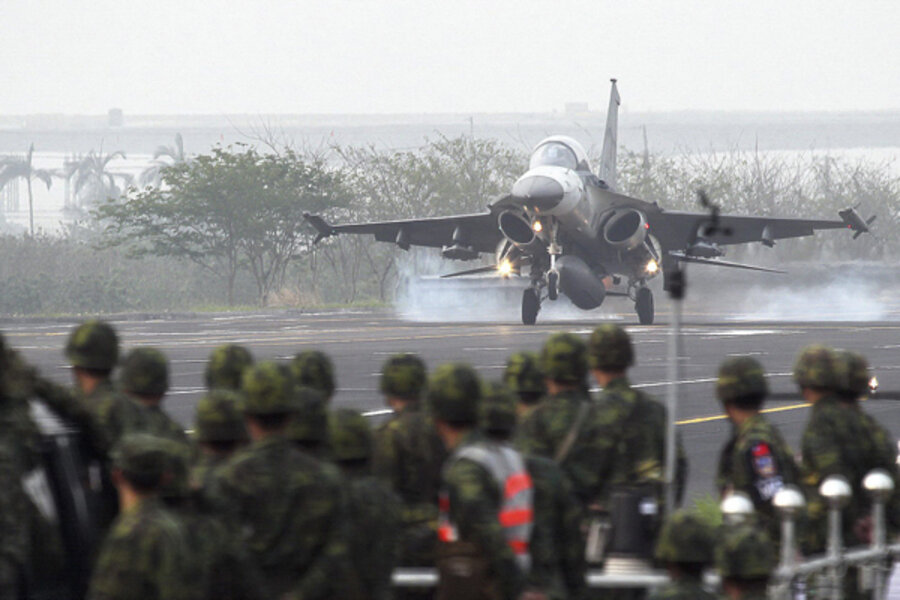Hard up for arms sales, Taiwan turns to its own defenses
Loading...
| Taipei, Taiwan
Taiwan’s deployment of a third generation of Brave Wind antiship missiles signals a growing reliance on homemade weapons, which defense officials consider crucial as they worry the United States is backing away from selling advanced weapons to it.
The supersonic missiles now on 12 Taiwanese frigate warships and eight missile boats could hit enemy ships at higher speeds if China – or anyone else – attacked, said Deputy Defense Minister Andrew Yang. The deployment announcement – normally hush-hush – came late last week ahead of Beijing’s reported plans to finish work on its first aircraft carrier.
“It’s a continuous process in accordance with our defensive policy, which is defending the islands from attacks from afar,” Mr. Yang said.
The development in Taiwan’s indigenous hardware advances its long-term goal of greater military self-sufficiency as the US appears to waffle under pressure from China – which Taiwan considers a continuing threat – on whether to sell advanced weapons to the island as it has done for decades past.
“If you put too much emphasis on imports and something goes sour between importer and exporter, you end up with an empty hand,” says Liu Yi-jiun, public affairs professor at Fo Guang University in Taiwan.
Local weapons production also shows that China and Taiwan, which have occasionally flirted with war in the past 60 years, distrust each other despite talks since 2008 that have eased tensions through trade and transit deals. But China has never officially dropped threats to use force, if needed, to bring the self-ruled island into the fold.
Taiwan, which lags in the balance of power against China’s rapidly modernizing military stationed just 160 kilometers (100 miles) away at the nearest point, once looked to the US, its strong informal ally, for sales of defensive arms. President Ma Ying-jeou still pushes Washington to approve a request for as many as 66 F-16 fighter jets.
But Washington, also with trade on its mind, wants peace with economic powerhouse China and fears another angry backlash if it sells more weapons to the island that Beijing has claimed as its own since the Chinese civil war of the 1940s. Beijing fumed after Washington approved a $6.4 billion arms package to Taiwan last year.
As no other foreign supplier will step in, officials and experts say Taiwan has refocused on a 30-year-old effort to build its own systems, though officials give few details on budgets, timelines, and capabilities.
Taiwan has already made antiship, surface-to-air and air-to-air missiles, with quality steadily increasing, in addition to more commonplace sea mines and torpedoes.
Cause for worry?
China seldom comments officially on Taiwan’s military advances, but a multiple rocket launcher got the official Chinese media’s attention this year after – those media said – it was deployed on an outlying island near China but later retracted. News of the Brave Wind IIIs, which can travel at twice the speed of sound and have a range of 130 kilometers, also made it onto the Communist Party-run People’s Daily online forum.
More attention may come if Taiwan pursues widely reported plans to build a ballistic missile, the Hsiung Feng-2E, with a range of 1,000 kilometers and armed with a 400-kilogram warhead. Overall, both China and the US have some cause to worry, experts say.
“Despite China's advancing military modernization, it still has to overcome Taiwan's formidable missile threat,” said Wendell Minnick, Asia bureau chief with Defense News. “I would not want to be on Chinese destroyer or frigate in the Taiwan Strait during a war. Not that different from shooting fish in a barrel.”
US officials urged Taiwan to drop its homegrown weapons under then President George W. Bush and fear that China would blame them for any attack from Taiwan even involving indigenous weapons, says Bonnie Glaser, senior fellow with the Freeman Chair in China Studies under the US think tank CSIS.
“During the Bush administration, the US put a lot of pressure on Taiwan to stop this program, and yet it continued,” Ms. Glaser says. “That suggests that Taiwan is serious about developing the capability and about an indigenous weapons program.”
But China ultimately has less to fear than Taiwan, analysts say. By the numbers, its air power, submarines and 2.3 million troops far outstrip Taiwan, which is shifting toward an all volunteer service by 2015 even as China’s 2011 military budget of about $92 billion exceeds Taiwan’s by 10 times.
“We cannot afford to be engaged in an arms race with China,” says Raymond Wu, managing director of the Taipei-based political risk consultancy etelligence. “Development of indigenous arms is to show we are doing the best we can."





